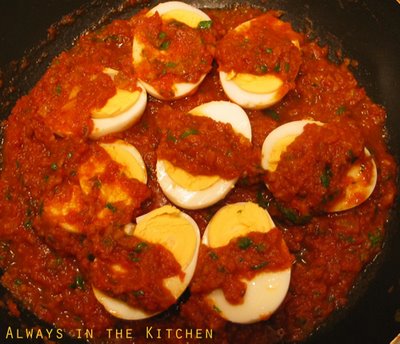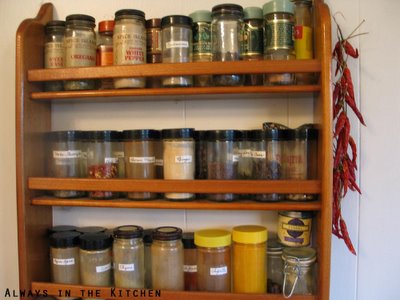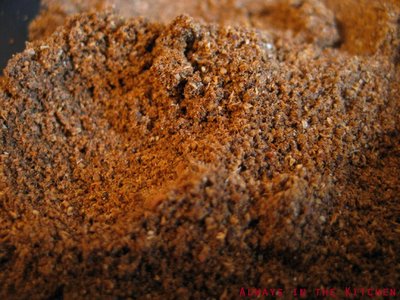
Khichdi (aka Khichri, and a number of other variations, खिचड़ी in Hindi) is a rice-and-pulse dish from India that is not only a vegetarian (vegan, in fact) staple, but also very likely the ur recipe for Kedgeree and possibly even Middle Eastern Koshary. It's been around for a long, long time, and is considered to be a very balanced meal on its own - even better, if you can serve it with condiments such as yoghurt or raita, chutney, or go all out for the famous Hyderabadi combination of khichdi, kheema, and khatta.
Kheema (aka keema, कीमा in Hindi) is essentially a simple, loose, ground meat gravy seasoned with accent vegetables and vigorous application of spices as pleases the cook. My kheema tends to vary quite wildly depending on what I have on hand, but is usually at least a bit spicy. Kheema is not generally by nature a vegetarian dish, but one could make it so by using the ground-meat substitute of your choice, or even simply finely minced vegetables. This one has a mixture of ground lamb and beef, as prepared by our local Turkish butcher. The recipe is below the recipe for the khichdi.
I didn't have the necessary sour ingredients on hand to make khatta, but we enjoyed the khichdi and kheema together.
There are different styles of Khichdi, ranging from the dry, pilau-like separate grains you see here to a more risotto-like dish, more of an extremely thick soup or congee than its drier pilau cousin. Because I was using a lentil that holds its shape very tenaciously, I decided to go with the drier style.
Khichdi can be made with any lentil, but this one is made with whole black urad dal - the same pulse that I use to make Kali Dal (black dal), and this dish is therefore Kali dal ki khichdi. Because the lentils give off a lot of dark colour when boiled, I discard the water used to boil the lentils, but if you don't mind a grey dish, you can certainly use the cooking water to also cook the rice.
Kali Dal Ki Khichdi
Serves 4
150 - 180 mL whole black urad dal, picked over and rinsed well
approximately 6 cups cooking water for the dal
1 teaspoon toasted cumin seeds
2 tablespoons minced fresh ginger
2 teaspoons oil or butter or ghee
1/2 teaspoon kosher or other coarse salt
1-3 dried red chilies, left whole OR 1 long fresh chili, seeded and chopped.
200 grams basmati rice
310 mL water for the rice, rinsed well
You don't need to soak the dal, but you can if you want to. You do need to wash them well, or your dish will be gritty.
In a moderately large pot, bring six cups (or so) of water to a boil. Add the well-rinsed dal, the cumin seeds, the chilies and the minced ginger, and let simmer gently for about 45 minutes, stirring from time to time. The water will be very dark and murky looking. If your dal is a bit old, or you're not convinced of its freshness (mine was rescued from the back of the cupboard), a small pinch of baking soda can be added to the water to encourage the dal to soften nicely as it cooks.
When the dal is tender, drain through a colander, and set briefly aside while you get the rice going: in a medium pot, bring the rice-cooking water and the well-rinsed rice to the barest of bubbles rising to the surface. Add the oil or butter or ghee, the salt, and the drained dal, stir through, and cover with a tight-fitting lid. Turn the heat immediately to the lowest setting, and cook undisturbed (no peeking!) for 15 minutes. Transfer the pot to a cold burner (or pot holder) without lifting the lid, and set the timer again for 15 minutes. When the timer goes, you may open the pot and fluff up your rice with a fork or rice paddle.

You'll notice that the dal have congregated in the top third of the dish, so give it a nice fold with a paddle or spatula to disperse them throughout the rice. If you want to serve it in a tidy shape, you can pack it into a small bowl or measuring cup and upend onto the plate or bowl. Otherwise, just spoon it into a bowl and enjoy - with or without accompaniments.

Plain yoghurt is a very common side, and if the khichdi is being eaten on its own, you may want to consider a tempering made from heating a little mustard oil (or butter or ghee) in a small pan, and adding some chili flakes, swirling them about until fragrant, before pouring over the khichdi. Because we were serving this with kheema, we didn't do that extra step.
* * * * *
A note on kheema vegetables: One of the most popular and traditional vegetables to add to kheema is green peas. If you're not using the peppers and/or tomatoes.
Simple Kheema
Serves 4
500 grams ground beef and lamb (both or either)
1 tablespoon butter or oil
1 tablespoon finely minced ginger
1 medium yellow onion, chopped (about a cup's worth)
2 cloves garlic, sliced
1 teaspoon toasted cumin seeds
1 teaspoon ground coriander seed
1/2 teaspoon ground cardamom
1/2 teaspoon ground black pepper
1/2 teaspoon kosher or other coarse salt
3-4 roma-type tomatoes, cored and seeded, sliced into strips
1-3 red or green hot peppers, cored and seeded, sliced into strips
1/2 teaspoon garam masala
Water, as needed
1 teaspoon cornstarch or 1 tablespoon flour as a thickener (optional)
Cilantro to garnish (optional)
In a large skillet, heat the butter (or oil) over medium-high heat, and when it has melted and foamed out, add the ground meat. Stir and cook the meat, breaking it up with your spoon as you go (it can be as fine or coarsely broken up as you like) until it is thoroughly browned (not just no-longer-pink, you want some golden, flavourful searing on about half of it). Add the salt and the spices (except the garam masala) and stir through again. Add the onions, garlic, and ginger, and continue to stir and fry until the onions are translucent.
If you want a thicker gravy, choose either the cornstarch or wheat flour option (see instructions below) add it now and simmer for about 15 minutes. If you want a thinner gravy, simply add an extra half cup of water now simmer for about 5 minutes.
Add the hot peppers and the tomatoes (if it looks like it needs more water to be a nice gravy texture, go ahead and add a little more), and cook a few minutes longer, stirring frequently, until the vegetables are just tender. Garnish with cilantro if you like.
Thickener Options:
Cornstarch: mix the teaspoon of cornstarch with a half-cup of room temperature or cold water, stir until smooth, and then add to the pan. Stir throughout, and watch it thicken the gravy as it comes up to a simmer.
Wheat flour: mix the tablespoon of flour with a cup of room temperature or cold water by shaking together in a tightly lidded cup. Pour the liquid into the pan and stir throughout, and watch it thicken the gravy as it comes up to a simmer.


































